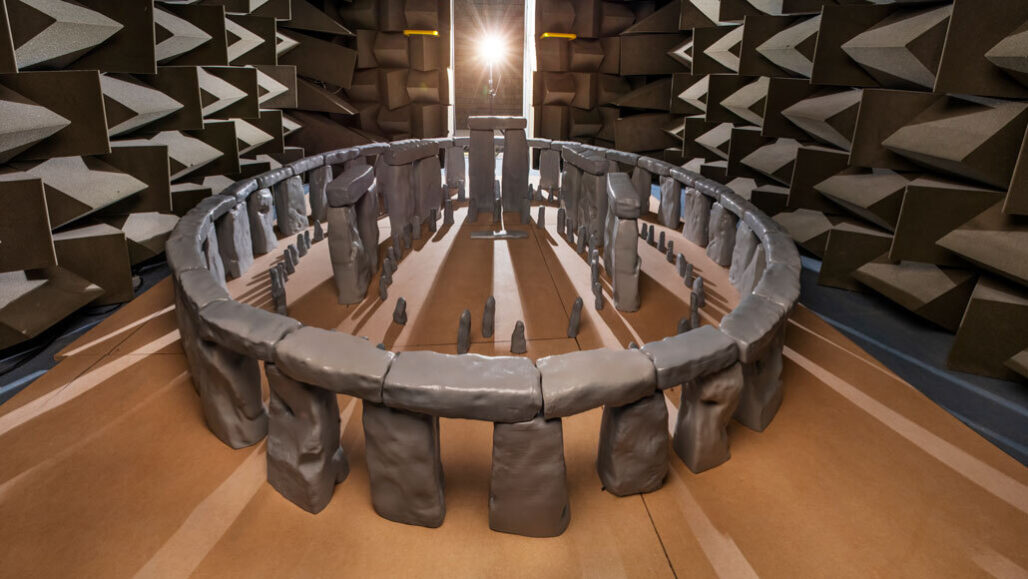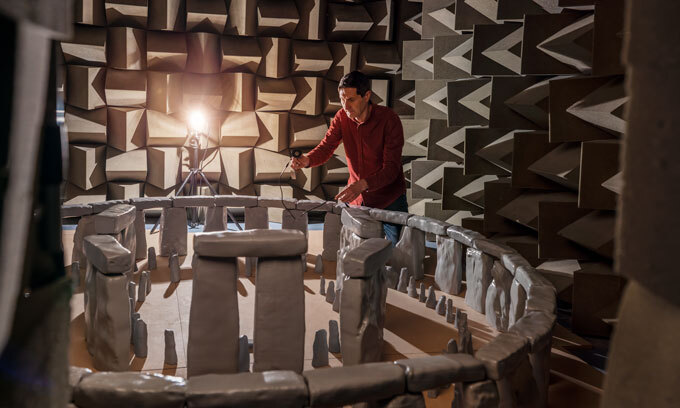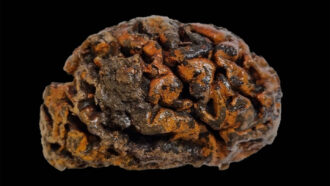Stonehenge enhanced voices and music within the stone ring
Scientists built a one-twelfth scale model to study the ancient site’s acoustics

One-twelfth the size of original, this scale model helped scientists discover that Stonehenge would have amplified speech and improved musical sounds — but only for those inside the stone circle.
Acoustics Research Centre/Univ. of Salford
By Bruce Bower
Welcome to Soundhenge. Ok, it’s really called Stonehenge. But this ancient monument in southern England is a marvel of acoustics (Ah-KOO-stix). Its massive stones would have amplified voices and enhanced music for people within the massive circle, a new study suggests.
The way the stones were placed created a defined acoustic space. Speech or music inside it would not have leaked out into the surrounding countryside. Not even people standing near the stone circle would have heard, says Trevor Cox.
His team describes Stonehenge’s sound in the October Journal of Archaeological Science.
Cox is an acoustical engineer. That means he’s interested in how sound interacts with objects. To explore any effect of Stonehenge on sound, Cox and his colleagues built a scale model. They used laser scans of the site and archaeological evidence to mimic the real thing as closely as they could. They made a scale model 2.6 meters (8.5 feet) in diameter. That’s one-twelfth the size of the actual monument. It’s as big as it could be and still fit inside an acoustic chamber at the University of Salford in England. That’s where Cox works. This room simulated how sound would have behaved due to the hard ground inside the monument and the open landscape around it.
Cox dubbed the model “Stonehenge Lego.” His team made fake rocks that they could move and reposition. Their design was based on a historic reconstruction of the Stonehenge of 4,200 years ago. It had an estimated 157 stones, including 30 standing stones in the outer ring. (Stonehenge today has 63 complete stones and 12 broken ones.)
First, the researchers 3-D printed 27 stones to match the sizes and shapes present. They made silicone molds of the printed stones. Then they used plaster mixed with other materials to cast the other 130 stones. The model stones were designed to absorb as little sound as possible, Cox says. That’s another way they’re much like the actual stones at Stonehenge.
Finally, the team placed speakers and microphones at various points inside and just outside Stonehenge Lego. Each speaker emitted chirping sounds that swept from low to high frequencies. The sound pitches were scaled to match the size of the model. That way they interacted with the model stones much as natural sounds behave at real Stonehenge.

Stone sounds
Despite all the gaps between stones, sounds briefly lingered inside Stonehenge Lego, the team found. The researchers calculated the reverberation time in the model. That’s a measure of how long it takes sound to decay by 60 decibels. (That equates to one one-millionth of the original sound energy. At that point, the sound is basically gone.) A longer reverberation means the sound would linger longer.
Mid-frequency sounds inside the model lasted an average of about 0.6 second. That effect would have boosted the ability to hear voices in the circle. It also would have enhanced the sounds of drums or other musical instruments, Cox says. How does that compare to places you might hear music today? Sounds may reverberate about 0.4 second in a living room. It would last around two seconds in a large concert hall and roughly eight seconds in a large cathedral.
Stonehenge Lego did not project sound into the surrounding area. Nor did it boost the quality of sounds coming from external speakers. And sounds did not echo in the scale model. Inner groups of simulated stones helped block echoing. They obscured and scattered sounds reflected off the outer stone circle.
The acoustics at Stonehenge have been studied before. But that work was incomplete, says Timothy Darvill. He’s an archaeologist at Bournemouth University in England. He has excavated at Stonehenge but was not part of the new research. Some work measured sounds at what remains of Stonehenge today and at a concrete Stonehenge replica in Washington state. Another acoustic study used a computer model of the ancient site.
The new study was “carefully and rigorously done,” says Rupert Till. He is a musicologist at the University of Huddersfield in England. He has used a computer to model the acoustics at Stonehenge. Still, many questions remain about the site’s sound, he says. A wider range of acoustic measures could help detect echo effects in the scale model, Till argues. Such echoes are present at Stonehenge. What’s more, he notes, “Stonehenge hums when the wind blows hard.” Why it does that remains a mystery.
It’s not known what, if any, ceremonies or activities occurred at Stonehenge. The site did serve as a cemetery between around 5,000 and 4,400 years ago. But any role of sound is unknown. In fact, Cox cautions that designers of Stonehenge may have had bigger concerns than acoustics. They likely focused more on factors such as treatment of the dead and the stones’ alignment with the sun and stars.
Whatever people once did at Stonehenge, the new study “shows that sound was fairly well contained within the monument.” This suggests its ring of stones “was fairly well insulated from sounds coming in,” Darvill says. Imagine hearing sounds circling inside the ancient monument. That, he says, “must have been one of the fundamental experiences of Stonehenge.”







